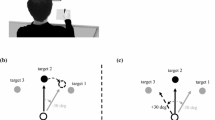Abstract.
Using the multiple-exposure approach, we investigated sensorimotor adaptation by exposing human subjects to different angles of visual rotation in a tracking task. Generally, the tracking error was high at the onset of the visual rotation and gradually declined towards the baseline level during the exposure period. In experiment A, we confirmed that the initial tracking error increases more than proportionally with the angle of rotation. In experiment C, we were unable to confirm intermanual transfer, and attribute this discrepancy with previous literature to details of the experimental tasks. In our main experiment, B, we found that pre-exposure to 45° or 60° of visual rotation facilitated the subsequent adaptation to a 90° rotation, with the facilitatory effect being more pronounced following the 60° rotation. We interpret this finding as evidence that adaptation is achieved by a gradual process, which progresses from small angles of output transformation through intermediate values up to the prescribed angle of rotation.
Similar content being viewed by others
Author information
Authors and Affiliations
Additional information
Electronic Publication
Rights and permissions
About this article
Cite this article
Abeele, S., Bock, O. Mechanisms for sensorimotor adaptation to rotated visual input. Exp Brain Res 139, 248–253 (2001). https://doi.org/10.1007/s002210100768
Received:
Accepted:
Issue Date:
DOI: https://doi.org/10.1007/s002210100768




